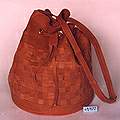In Sri Lanka, for a very long time, no attempt was made to convert leather-work into commercially viable products. Organised leather-work began with the establishment of the tanning industry in Sri Lanka, close to the beginning of the last century. Leather craft has finally gained momentum due to its earning potential. The Leather Products Corporation, a government body, has contributed a lot to the growth of this craft. There is a great local demand for leather goods, chiefly utilitarian articles for daily use, and decorative pieces.
PROCESSES & TECHNIQUES
Prepared leather for creating leather items is obtained from the local tanneries; the craftspeople do not involve themselves in the cleaning and tanning process. The chief processes involved in the making of the leather products are stitching, embroidering, pasting, and fixing of accessories.
The material is cut according to required dimensions and then sewn on a machine. Designs are either carved or embossed on the products. This process of carving is mainly done by hand using a sharp carving knife; embossing is done on a home-made press that is designed and made by the craftsperson(s). The procedure is fairly simple: the design is cut on wood or on a plastic sheet and the leather is pressed against this with a press, thus embossing the design on the leather.

GEOGRAPHICAL FOCUS
The areas of Sri Lanka in which this craft is practised include Vathiri and Moor Street in Jaffna district, at the northernmost tip of this island-country. In Ampara district, leather craft is practised at Uhana.
CONTEMPORARY TRENDS
1. PRODUCT RANGE
The contemporary product range is varied; common items comprise key rings, cuff links, book-marks, comb-cases, purses and wallets, watch straps, belts, mirror frames, optical cases, and hand- and shoulder bags. These items are well-designed and well-finished and are popular with affluent consumers and wealthy tourists. Leather products have become increasingly popular chiefly because living standards are rising. Both affluence and upwardly-mobile lifestyles are reflected in the market for elegant leather travel items like suitcases, travel bags, attaché cases, and portfolios. Enhanced living standards have become a reality in Sri Lanka after the traumatic period of ethnic strife in the country. New industries have been set up and there has been an upswing in the export earnings from staples of the country.

2. FOREIGN MARKETS
A lot of the leather products as fashion accessories have a market in the affluent societies abroad, especially due to the attractive prices which are possible due to low cost of production and good quality of products.
CONCLUSION
In view of the fact that the market for leather goods has a predominance of affluent buyers and that leather products have to combine utilitarianism and fashion, the products need to be finished well. Hence, the artisan’s skill is of great import. Government bodies like the Sri Lanka National Design Centre, the Sri Lanka Handicrafts Board, and the Industrial Development Board provide a lot of guidance to apprentices and artisans, through classes, and workshops, as well as regular instructions in the craft. The Sri Lanka Leather Association is also active, and organises exhibitions and other similar opportunities for the products to be displayed and sold. At present, what is of critical importance in the leather craft is the development of sustainable technology for improved designs and higher productivity.
Gallery
YOUR VIEWS
PRACTITIONERS: INDIA
Access 70,000+ practitioners in 2500+ crafts across India.
BIBLIOGRAPHY
10,000+ listings on arts, crafts, design, heritage, culture etc.
GLOSSARY
Rich and often unfamiliar vocabulary of crafts and textiles.
SHOP at India InCH
Needs to be written.






